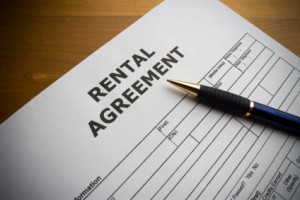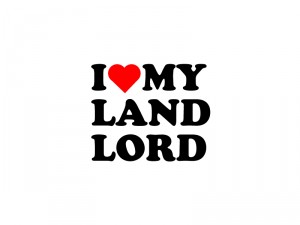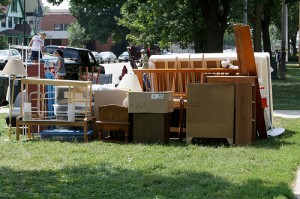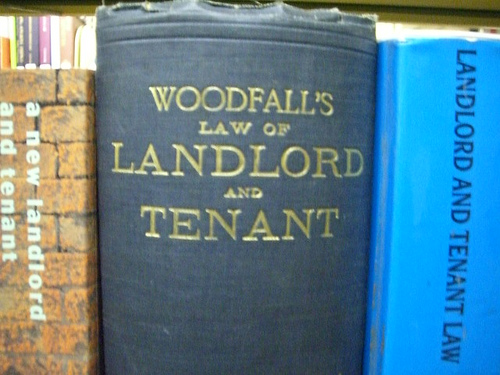Posted by Teresa on December 21, 2011 under Landlord Tips | 
 It’s time to put together your New Year’s Resolutions for 2012. And while you are probably an excellent landlord in every way, you may be considering making a few improvements in the New Year. To help, we’ve compiled a list of landlord behaviors to avoid:
It’s time to put together your New Year’s Resolutions for 2012. And while you are probably an excellent landlord in every way, you may be considering making a few improvements in the New Year. To help, we’ve compiled a list of landlord behaviors to avoid:
- Avoid the temptation to go through your tenants’ private spaces. Sounds like a no-brainer, since tenants have the right to privacy, even though they live in your property. But when a tenant recently reported coming home and finding the contents of her closet on the floor, along with a note saying that overstuffing will break the door, it apparently needs to be addressed.
- Don’t show up at your tenant’s door without the appropriate notice, as specified by the law and in the lease. Even if you’re already in the neighborhood, and you just want to stop in and change the furnace filter, and it will only take a moment, avoid this bad habit. Unless you see an imminent threat to your tenant’s safety, you need to give them proper notice.
- Avoid being like the San Francisco landlord who is being sued for $10 million by his tenants for failing to deal with bugs and mold. We’ll never be able to completely eradicate the rats, bedbugs, cockroaches, and other creepy crawlies that most people do not enjoy having around. But it’s a landlord’s duty to provide a safe and habitable living unit. And mold is a serious health hazard, especially for those with asthma or compromised immune systems. So if your tenants report a problem with bugs or mold, take care of it.
- Don’t discriminate against your tenants or prospective tenants. Raise your awareness of what constitutes discrimination—because it’s illegal. For example, one Ohio landlord recently got in trouble for her “White Only” pool sign. She said it’s an antique, and must have thought it was harmless, but one tenant didn’t find it to be harmless. The landlord has been fined by the state Civil Rights Commission, and is appealing the charges
Landlords aren’t perfect—and neither are tenants. But it’s important to keep a professional business relationship with your tenants—keep that in mind as you go into the New Year!
Posted by Teresa on October 19, 2011 under Landlord Tips | 
 The landlord-tenant relationship is a unique one. While your tenants are essentially your customers, the dynamic is quite different than in a typical retailer-customer situation. But as with any relationship, communication is the key to a successful landlord-tenant relationship.
The landlord-tenant relationship is a unique one. While your tenants are essentially your customers, the dynamic is quite different than in a typical retailer-customer situation. But as with any relationship, communication is the key to a successful landlord-tenant relationship.
Experienced landlords with successful rental property businesses know a few tricks and tips. Here, we’ve compiled a list of 8 tips to improve landlord-tenant communication, from real landlords.
- Don’t hesitate to over communicate: More is usually better than less when it comes to communication. Provide checklists, notices, friendly tips and regulations for tenants, so everyone is clear on your expectations.
- Don’t make assumptions: If you’re wondering about what’s going on with a tenant as it relates to your rental property, don’t assume you already know the answer. Simply ask.
- Respect boundaries: Even in an attempt to be a good communicator, you can’t call tenants at all hours, expect them to allow you in their unit without notice, or stop them on their way to work to discuss an issue. Be respectful of their time and space. And by all means, stay out of the tenant’s personal life, unless it affects your rental property, the lease or any other legal obligations.
- Keep the lines of communication open: Let tenants know that you are always willing to discuss a problem or answer a question—and back up your word with your actions.
- Ask each tenant about preferred means of communication: It might require a little more effort on your end, but to maintain a high level of communication, you need to reach tenants in the manner they prefer. For some, that’s a phone call. For others, it’s a text. Still others respond best to e-mail. For legal notices, U.S. postal mail is usually required, and would not be subject to a tenant’s preferences.
- Put it in writing: Don’t agree to anything without a written agreement. Allowing an extra parking spot, a kitten, or a wall-mounted flat-screen TV is up to you, but don’t let it happen with just a verbal agreement. Most people would be hard-pressed to later recall what the agreement was, and they usually don’t stand up in court.
- Clarify: If you’re unclear about something you’re hearing from a tenant, say so. Communicate what you heard and ask if that is what they meant.
- Listen: This is the most important of the tips for improving communication. Poor listening skills can kill a landlord-tenant relationship. Listening is challenging in some situations, but with practice, anyone can learn to avoid interrupting when someone is speaking, show interest through active listening and provide feedback.
Posted by Teresa on October 7, 2011 under Landlord Paperwork and Forms, Lease and Rental Agreements | 
 When leases are about to expire, landlords need to decide whether or not to renew and re-sign with a tenant, or notify them there will be no lease renewal. It’s important to know the terms of your lease agreement, obviously, but most require a 60- or 30-day notice from either party if a lease will not be renewed. Remember, it’s up to the landlord whether or not to offer a new lease and keep a tenant. Of course, tenants who wish to move have the option to end the relationship at the end of the lease, but if the landlord decides a tenant is out, there’s not much a tenant can do.
When leases are about to expire, landlords need to decide whether or not to renew and re-sign with a tenant, or notify them there will be no lease renewal. It’s important to know the terms of your lease agreement, obviously, but most require a 60- or 30-day notice from either party if a lease will not be renewed. Remember, it’s up to the landlord whether or not to offer a new lease and keep a tenant. Of course, tenants who wish to move have the option to end the relationship at the end of the lease, but if the landlord decides a tenant is out, there’s not much a tenant can do.
Landlords need to know in advance if a tenant plans to stay or move. It’s not a bad idea to send the tenant a notice, ask if they’re staying or leaving, and have them check a box: I’m interested in renewing; or I’m moving out. Sending a notice ahead of time is also a great way to remind tenants that any security deposit paid is just that—and that the last month’s rent will be due as usual, with the security deposit covered separately.
If the tenant is paying rent on time and abiding by the terms of his or her lease, it’s to the landlord’s advantage to keep the tenant in place, avoiding the expenses and time associated with finding a replacement. Some landlords who want to keep their tenants send a friendly letter notifying them that the lease is up for renewal, and offering a discount on the standard annual rent increase because they are “preferred tenants.” Others put the new rent at the standard rate and offer a $50 gift card, new light fixtures, or some other perk for renewing.
The strong rental market means landlords can be a bit choosier. So if a lease renewal date is coming up and a tenant no longer fits your requirements, you simply need to notify him or her that you will not be renewing the lease. Give at least 30 days’ notice, or more if you lease or local laws require it.
3 Reasons to Let a Bad Tenant Go:
- Late rent: Even if a tenant pays the rent every month, if they pay late every month, it’s a hassle. Get someone in who will pay every month, on time.
- Breaking terms of lease: Every item in the lease was agreed to by your tenant when they signed it. If you have a tenant who is smoking in a non-smoking unit, or piling garbage around the dumpster instead of in it, or taking up three parking spots instead of one, you may decide that you no longer wish to put up with the headaches a tenant like this can cause.
- High maintenance: Certainly, legitimate complaints about repairs and maintenance are your responsibility as a landlord. But if you have a tenant who complains about a light bulb burning out, or the lack of air conditioning in a unit that never had it, or any number of other insignificant non-issues, you have the right to not renew the lease.
Protect your rental property and assets through tenant background checks. Proper tenant screening will ensure you are leasing to the best possible tenants.
Posted by Teresa on July 6, 2011 under Landlord Paperwork and Forms, Landlord Tips, Lease and Rental Agreements | 
 Most landlords we know require each person over 18 who lives in a rental unit to be on the lease. Most require each roommate to fill out a lease application, and undergo tenant background and credit checks. And that’s the extent of involvement for most landlords we know.
Most landlords we know require each person over 18 who lives in a rental unit to be on the lease. Most require each roommate to fill out a lease application, and undergo tenant background and credit checks. And that’s the extent of involvement for most landlords we know.
Roommates don’t always work out, which can cause headaches for landlords. If you’ve experienced your share of roommate drama, you can help educate your tenants to be better roommates—which in turn can make them better tenants for you.
Why not provide all of your tenants with a Roommate Agreement? Here’s what it can do for you:
- Facilitate better tenant relationships
- Minimize roommate arguments
- Increase awareness about legal responsibilities
While the agreement will not alter the terms of the lease each tenant is subject to, it serves to clarify some of the issues roommates often have with each other. Be sure that the agreement states that the roommates are jointly and severally liable for all terms of the lease/rental agreement. And of course, have a legal professional review it before you hand it over to your tenants.
What to Include in a Roommate Agreement
- Address of rental unit and lease beginning and ending dates.
- Name of each roommate, share of rent and security deposit each is responsible for, and which bedroom is his or hers.
- Security deposit rules: an agreement that whichever roommate is clearly responsible for damages will pay any applicable fees in full. All roommates agree to share equally in the cost of other fees and damages.
- Utilities: Determine in whose name the utilities (electricity, water, gas, cable, phone) will be and how the roommates will split and pay the bills.
- Subletting: State whether subletting is or is not allowed under the terms of the lease. If so, specify guidelines.
- Guests: Specify that each roommate is responsible for guest behavior, determine where each guest may stay, and the consequences when guests cause trouble or any damages. Place a limit on the number of days a guest may stay, according to the terms of the lease and the roommates’ comfort level. Specify whether guests may smoke and who is responsible for cleaning up after them.
- Quiet hours: state when roommates agree to observe quiet hours for sleep, study, etc.
- Pets: Guidelines for pet owners, according to the terms of the lease.
- Smoking: If the lease allows smoking, this section can spell out whether or not it is allowed by the roommates, and if so, where.
- General household rules: State who is responsible for trash and recycling, where to park vehicles and bicycles, guidelines for cleaning, sharing food, etc.
All roommates should sign and date the roommate agreement. While these guidelines may seem obvious, a formal agreement where all terms are spelled out and agreed to in the beginning can avoid many typical roommate problems. Good roommates make better tenants, and accepting the responsibilities that go along with living together can make the situation much more pleasant for everyone involved!
Posted by Teresa on February 19, 2011 under Landlord Tips | 

Verify Before You Hand Over the Keys to a New Tenant
When a new tenant moves in, do you welcome them with open arms, or just hand over the keys? Great tenants are few and far between, and even good tenants make your life much easier. So why not show your appreciation and start the landlord/tenant relationship off right?
Lots of landlords we know present a new tenant with a welcome package of goodies. Some cost them little to nothing out of pocket—say, $10 – $15. Others keep it strictly business and include just the legalities.
If you choose the former, here are a few items to include in a welcome package that will make your new tenant feel right at home:
- A list of emergency phone numbers. This might seem old-fashioned when a simple call to 911 will fetch police, fire and ambulance. But your tenants also need to know how to get in touch with your preferred maintenance people in an emergency. Do include the numbers for your plumber, electrician and general maintenance provider, along with utility companies.
- A floor plan clearly indicating the emergency evacuation route, location of fire extinguishers and smoke alarms and emergency water shut-offs.
- Coupons for local businesses. Stop by the neighborhood pizza shop, dry cleaner, deli and other businesses that might love to have your new tenants for customers. See if you can strike a deal with the pizza shop for discounted gift cards and include one as a gift for move-in day.
- Bus routes, trail and bike maps. More and more tenants are ditching their cars for alternative forms of transportation. Make it easier for them to find the right bus, bike to work, or go for a walk or run on nearby trail.
- A few of life’s necessities, like toilet paper, paper towels and a few extra batteries for the smoke detectors. These low-cost items can really make a big difference when moving into a new place.
Remember, a small effort can actually go a long way to establishing a good relationship with your new tenants. And even if some don’t seem to appreciate it, you might be reaping unseen rewards in the form of fewer problems and happier tenants!
Posted by Teresa on January 19, 2011 under Landlord Tips | 
 The business of renting property is never perfect. It can be tough. Sometimes, it can be really tough. But today we’re going to focus on what landlords can do to make their properties better places to live. And who knows? These efforts can pay off in happier tenants, longer leases, and higher-quality applicants.
The business of renting property is never perfect. It can be tough. Sometimes, it can be really tough. But today we’re going to focus on what landlords can do to make their properties better places to live. And who knows? These efforts can pay off in happier tenants, longer leases, and higher-quality applicants.
- Your rental property is kid- and pet-friendly. While this doesn’t work for every property, it does make things easier for parents of two-and four-legged kids. Provide and enforce clear-cut rules, along with designated areas for kids to play and dogs to do their business, and you can make nearly everyone happy—even your tenants who prefer to keep rugrats and furballs at arm’s length.
- Your rental property is fun. Creating positive interactions between residents, through potluck dinners, book and movie exchanges, a game room, or picnics can go a long way toward creating a community. People who know their neighbors feel more safe—and are more willing to look out for each other.
- Your rental property is welcoming. While it is the law that you do not discriminate on the basis of race, religion, family status, disability, sex and other factors covered by the Fair Housing Act, you create quite a different feeling when you advertise that everyone is welcome. Print a statement of welcome to all people on your leases, add it to your signage and your advertisements, too.
- You provide excellent customer service. Great landlords remember that their tenants are their customers. Without them, there is no rental business. All landlords know the feeling of less-than-100% vacancy; try to keep it in mind when servicing your tenants.
- You strive to accommodate everyone. Providing closer parking for disabled is the law, but reserving a few close spaces for older tenants, who might not have an actual disability is just a nice thing to do. Providing secure storage for bicycles encourages their use, which is good for the planet and the health of your tenants.
- You treat your tenants with respect in every interaction and communication. Few people cannot tell when they’re being disrespected or on the receiving end of a condescending attitude. If showing respect is difficult for you, then leasing property might not be the best business to be in.
Being a great landlord is not just a nice way to conduct business—it IS good business! Happy tenants will stay longer, cause fewer problems and recommend your property to their friends, family and co-workers. Why not strive to be a great landlord?
Pre-screen all tenants as part of your standard application process. Background and credit checks will help ensure you rent to qualified tenants. For more landlord resources, including forms and information on tenant screening, turn to E-Renter.com.
Posted by Teresa on December 14, 2010 under Landlord Paperwork and Forms, Landlord Tips | 
 Many tenants notify landlords of their plans to move at the end of a lease by mentioning it in passing. Others assume that, if they haven’t signed a new lease, the landlord knows they are moving and they don’t need to notify.
Many tenants notify landlords of their plans to move at the end of a lease by mentioning it in passing. Others assume that, if they haven’t signed a new lease, the landlord knows they are moving and they don’t need to notify.
It’s a good idea to require tenants to provide a written notice of their intent to move. Many states require it, and if you use a well-written lease, it probably does as well.
The Advantages of Written Notices
Requiring tenants to put their intentions in writing is a good idea for several reasons:
- It eliminates the mix-up that can occur with verbal notifications
- It keeps the landlord/tenant relationship more businesslike
- It may be state law
- Written notices leave nothing to the imagination
- You won’t forget the tenant’s move-out date, which can lead to problems
- You’ll have time to prepare the security deposit return or deductions
What to Include on a Tenant’s Notice of Intent to Vacate Unit
Use a simple form, either one you obtain online or one you create yourself. You can provide it to tenants at lease signing, although it’s not likely they’ll keep it around long enough to turn it in at the end of the lease. Many landlords provide a form to tenants 60 or 90 days before the lease is up, with instructions to return it within 30 days of the end of the lease, if they plan to move.
The form should include:
- The date the form was completed;
- The name of the landlord or property management company;
- The address of the rental unit;
- Legal language including: The undersigned Tenant (name) hereby gives written notice of intent to vacate the rental unit at (address) on (date);
- A statement that the tenant understands they are responsible for rent until the end of the current lease or the day they vacate the unit, whichever is later;
- A statement that in accordance with the lease, the landlord is allowed reasonable access with advance notice to show the rental unit to prospective renters or contractors;
- A line for the tenant to sign and date the form.
As you can see, a thorough tenant move-out form covers all the bases: the date of the move-out, the day the rent is to be paid through, and permission to show the unit or allow access to workers.
Landlords who want even more information can include a short survey on the form, asking why the tenant is moving and if there is anything that could have been done to keep him or her as a tenant. This type of feedback is extremely valuable!
Pre-screen all tenants as part of your standard application process. Background and credit checks will help ensure you rent to qualified tenants. For more landlord resources, including forms and information on tenant screening, turn to E-Renter.com.
Posted by Teresa on November 30, 2010 under Landlord and Tenant FAQs, Landlord Paperwork and Forms | 
 Many landlords we hear from believe that a thorough, well-written and lawyer-approved lease should contain all the rules and regulations a tenant needs to follow. And that’s partly true. But there’s a difference between the terms of a lease and the everyday policies you want your tenants to follow.
Many landlords we hear from believe that a thorough, well-written and lawyer-approved lease should contain all the rules and regulations a tenant needs to follow. And that’s partly true. But there’s a difference between the terms of a lease and the everyday policies you want your tenants to follow.
As a rule, leases are where the legalese lives: the legal description of the property, legal names of the parties involved, legal termininology, and the landlord’s legal recourse when terms are not followed. The “house rules” are generally more relaxed in language, are more flexible (i.e., they can change at any time with notice to all residents) and are simply intended to help everyone get along better and live in harmony. They are generally not legally-enforceable documents.
A signature on your list of policies or house rules is just as important as the signature on the lease. You want to be clear that your tenant understands the rules and agrees to abide by them. Review them together at the time of the lease signing, and be sure to ask if any item needs clarification.
10 Items to Include in Your Rental Property Rules
- Noise: Emphasize that consideration for other tenants is required, and that while your rental unit is well-constructed, it is not to be considered sound proof. Noises that disrupt others’ quiet enjoyment are not allowed. Include quiet hours, if desired.
- Window Treatments: Here you’ll include whether or not blinds or drapes are included with the rental unit and what care they require. If no treatments are provided, you may want to specify what color and type of coverings are allowed—and what are not allowed (like aluminum foil).
- Keys: Any key replacement fee should be included here, as well as emergency lock-out fees if a tenant forgets his or her keys after hours.
- Inclement Weather Procedures: Inform tenants of your requests during times of high winds, low temperatures, or high rain, as well as thermostat settings when the rental unit is occupied for specified lengths of time.
- Trash and Recycling: Tenants need to know what can be recycled and where it goes, along with non-recyclable trash.
- Parking: Where tenants are allowed to park, how many vehicles each unit is allowed to keep onsite, where not to park, and whether or not non-running vehicles are allowed are some of the rules you’ll want to spell out here.
- Common Areas: Are tenants allowed to leave property in common areas like hallways, sidewalks and patios? Who is responsible for clearing snow and ice from walkways? Spell these things out here.
- Storage: Indicate where tenant storage is located, how they can access it, and any limitations (flammables, vehicles, dangerous chemicals, etc).
- Guests: Include things like where guests may park their vehicles and tenants’ responsibilities for their guests.
- Bicycle Parking: As bicycle commuting becomes more popular, many tenants will want to know where they can park their bikes. If you don’t want them chained to fences or balcony railings, specify where bike parking is allowed. Better yet, create special areas for bikes that are convenient and secure for cycling tenants.
Presenting a friendly list of house rules lets all tenants know what is expected of them and their fellow tenants. After all, who (besides fraternity kids, perhaps) wants to live in a place where there are no rules?
Posted by Teresa on September 18, 2009 under Landlord Paperwork and Forms, Landlord Tips | 
 The relationship between landlord and tenant should be strictly a business one. Landlords must abide by a variety of federal, state, and local laws designed to protect tenants. Breaking a law, even unintentionally, can spell big trouble to a landlord. And rental property is too valuable to allow tenants to occupy it without the full protection of a legally binding agreement. It’s a mistake to let property without a proper rental agreement or lease. To do so opens a landlord to a great deal of risk, possible financial loss, and even litigation.
The relationship between landlord and tenant should be strictly a business one. Landlords must abide by a variety of federal, state, and local laws designed to protect tenants. Breaking a law, even unintentionally, can spell big trouble to a landlord. And rental property is too valuable to allow tenants to occupy it without the full protection of a legally binding agreement. It’s a mistake to let property without a proper rental agreement or lease. To do so opens a landlord to a great deal of risk, possible financial loss, and even litigation.
Lease or Rental Agreement?
A rental agreement allows a tenant to occupy property for a short period, often 30 days. And, it allows the landlord to increase the rent, change the terms, or terminate it altogether with a short written notice (usually 30 days, but that depends on each state’s laws). This type of agreement renews automatically at the end of the 30 days, unless the tenant or landlord gives written notice that it will end. This is a typical month-to-month type of rental situation.
A lease obligates both parties to a set of conditions and terms for a set period of time, usually one year. During the term of the lease, the landlord cannot raise the rent, and the tenant cannot move out, unless each party operates within terms of the lease that cover these areas. Landlords cannot ask tenants to move out until the lease expires. Either party can decide to not renew the lease with proper notification. Breach of the lease terms can result in eviction of the tenant by the landlord, or litigation between the parties.
Typically, the lease covers areas such as rent amount, term, rent due date, parking regulations, property care and maintenance, landlord entrance, pet policy, and other legal matters.
Rental agreements are more common in areas with high turnover, or where rents are increasing and rentals are in short supply. Leases are preferred by landlords where vacancy rates are higher or where tenants are harder to find.
Whether you decide to use a rental agreement or lease, the important thing is to make certain you are fully protected under a solid and binding legal document.
Remember, you are within your rights when
screening tenants prior to leasing. For more landlord resources, including forms and information on
tenant screening, turn to
E-Renter.com. You’ll know that you have the best possible tenants when you
prescreen tenants.
Posted by Teresa on September 14, 2009 under Screening and Background Checks, Tenant Credit Checks, Tenant Screening & Background Checks | 
 Pre-qualifying tenants means a good start to a mutually respectful, mutually beneficial landlord/tenant relationship. So what exactly is pre-qualifying, and how do you begin to implement this strategy? Here’s a list of what pre-qualifying is and is not:
Pre-qualifying tenants means a good start to a mutually respectful, mutually beneficial landlord/tenant relationship. So what exactly is pre-qualifying, and how do you begin to implement this strategy? Here’s a list of what pre-qualifying is and is not:
- Pre-Qualifying is about finding the people who fit the minimum requirements you set for income, references, job and credit history. Proper tenant screening will further narrow the field by giving you solid background check results to base your decision on.
- Pre-Qualifying is not about discrimination. As a landlord, federal law prevents you from using a person’s race, color, religion, nationality, familial status, age, gender, or disabled status to determine housing eligibility. Your state may have additional guidelines.
- Pre-Qualifying is about laying the groundwork for a great landlord/tenant relationship by communicating clearly and effectively from the start.
- Pre-Qualifying is about reducing tenant turnover by avoiding broken lease agreements and evictions.
- Pre-Qualifying is not about judging applicants based on personal appearance, the car they own, or the number of people in their family unit.
- Pre-Qualifying is about applying the same rules and requirements to all applicants.
- Pre-Qualifying is a way to reduce your risk by keeping tenants with previous criminal convictions or negative rental histories out of your rental properties.
- Pre-Qualifying is started by advertising your property for rent in the right publications, including enough information to weed out individuals who are not a good fit for your rental.
Every landlord should consider pre-qualifying tenants. While it takes effort to begin any new procedure, it will soon be a habit—and this is a habit that will pay off through better relationships with your tenants and increased profits for you!
 It’s time to put together your New Year’s Resolutions for 2012. And while you are probably an excellent landlord in every way, you may be considering making a few improvements in the New Year. To help, we’ve compiled a list of landlord behaviors to avoid:
It’s time to put together your New Year’s Resolutions for 2012. And while you are probably an excellent landlord in every way, you may be considering making a few improvements in the New Year. To help, we’ve compiled a list of landlord behaviors to avoid:








